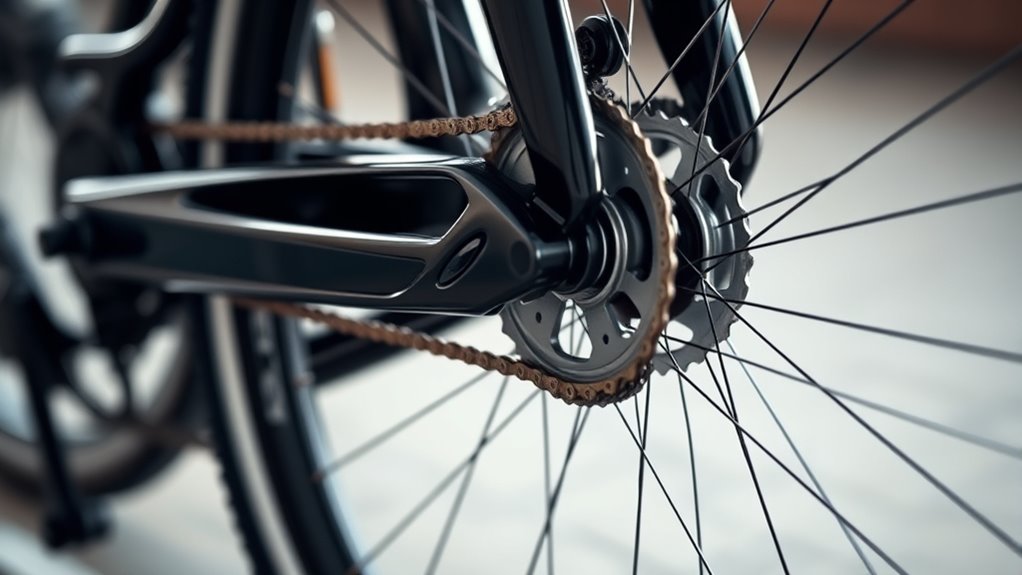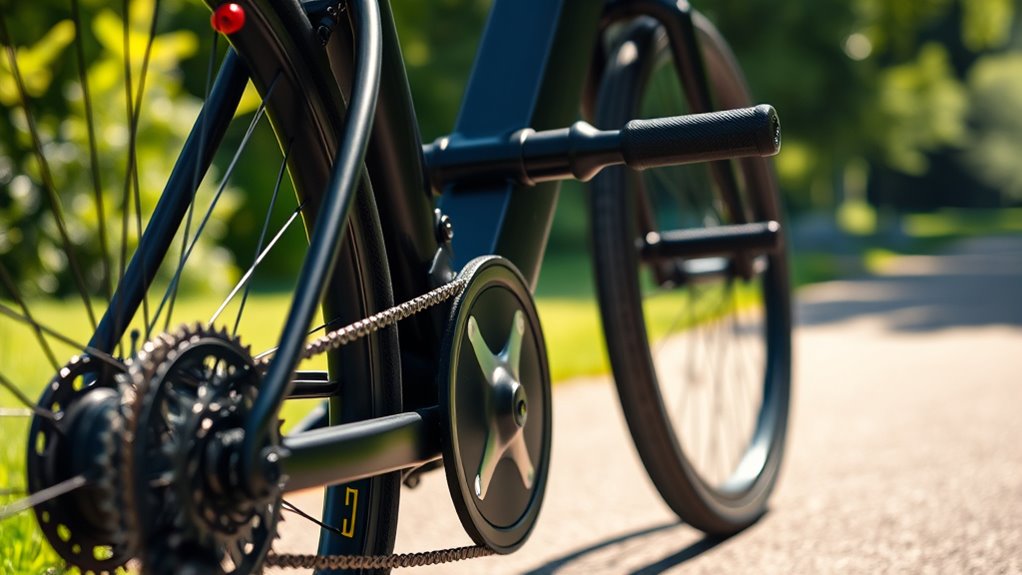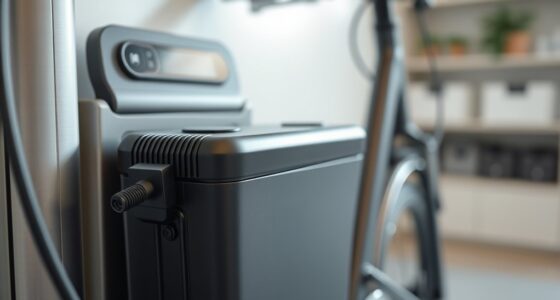To quiet your e-bike’s clicks, creaks, and whirs, start by inspecting the motor and drivetrain for loose or worn parts, and tighten all bolts. Check your tires for proper inflation and verify they’re balanced to prevent vibrations. Examine suspension components and wheel hubs for alignment and damage. Lubricate chains and gears regularly to reduce friction noise. For ongoing issues, proper maintenance and component checks will keep your ride smoother and quieter—continue exploring these steps to learn more.
Key Takeaways
- Inspect and tighten loose bolts on the motor, wheel hubs, and drivetrain to eliminate rattling and clicking sounds.
- Clean and lubricate the chain, gears, and moving parts to reduce creaks and whirs caused by dirt and friction.
- Check tire pressure and alignment for uneven wear or imbalance that can produce vibrations and noise.
- Examine suspension components for leaks or damage, and ensure proper alignment to minimize vibrations and creaking.
- Regularly inspect and replace worn or damaged parts to prevent noise escalation and maintain a quiet, smooth ride.

Quiet Your E‑Bike
If your e-bike has become louder than you’d like, there are simple steps you can take to quiet it down. Noise from your e-bike can stem from various sources, but motor noise and vibration issues are often the main culprits. Identifying where the noise originates is the first step toward reducing it. Often, the motor’s whirring or clicking sounds are caused by loose components or worn parts. Tightening these connections usually makes a big difference. If you notice any rattling or persistent clicking sounds, check for loose wiring or damaged connectors. Sometimes, dirt and debris can also cause irregular motor operation, leading to unusual noises. Cleaning the motor area thoroughly can help eliminate these issues. If your e-bike has a hub motor, ensure the axle bolts are tight; loose axles can cause vibration issues that translate into noise. Regular inspection and maintenance can prevent many of these problems from developing over time.
Next, pay attention to vibration issues that might be causing or amplifying noise. Excessive vibrations often originate from misaligned or worn-out parts. Check the wheel hubs for proper alignment and ensure the spokes are correctly tensioned. Uneven tire wear or low pressure can also contribute to vibrations. Make sure your tires are inflated to the recommended pressure, as under-inflated tires cause more bounce and noise. If your bike has suspension components, such as front forks or rear shocks, inspect them for leaks or damage. Worn suspension can increase vibrations, making noise more noticeable. Additionally, HEPA filters in air purifiers are designed to capture airborne particles effectively, highlighting the importance of regular maintenance for optimal air quality.
Another common source of vibration and noise is the drivetrain. Chain tension should be checked regularly, as a loose or overly tight chain can cause grinding, clicking, or whirring sounds. Lubricate the chain properly to minimize friction and reduce noise. Similarly, inspect the gears and derailleur for proper alignment and operation. Worn or dirty gears can produce squeaks and creaks that detract from a quiet ride. Lastly, consider the overall condition of your e-bike. Regular maintenance, like tightening all bolts and lubricating moving parts, can prevent many vibration issues and motor noise problems. Replacing worn-out components early can also save you from more substantial noise issues down the line. By systematically inspecting and maintaining your e-bike, you’ll reduce both motor noise and vibration issues, making your rides quieter and more enjoyable.
Frequently Asked Questions
Can Noise Indicate a Serious E-Bike Mechanical Issue?
Yes, noise indication can signal serious mechanical issues on your e-bike. If you notice unusual clicks, creaks, or whirs, it’s a sign that something might be wrong with the bearings, chain, or motor components. Ignoring these sounds can lead to more severe damage or safety risks. You should inspect your bike promptly, identify the source of the noise, and address any mechanical issues before riding further.
How Often Should I Lubricate My E-Bike Components?
You should lubricate your e-bike components every 30 to 50 miles or once a month, depending on your riding conditions. Following a regular lubrication schedule helps prevent rust, reduce wear, and guarantee smooth component operation. Make sure to focus on the chain, derailleurs, and brake pivots during your component maintenance. Keep your bike well-lubricated to enhance performance and extend the lifespan of all moving parts.
Are Certain Terrains More Likely to Cause E-Bike Noises?
Rough terrains like rocky trails or uneven dirt paths often cause more e-bike noises because they put extra strain on your bike’s components. Paved surfaces tend to be quieter, but if you ride aggressively or hit bumps, you might still hear clicks or creaks. To minimize noise, regularly check and lubricate moving parts, especially after riding on rough terrain, and confirm your bike is properly maintained for smoother, quieter rides.
What Safety Precautions Should I Take When Inspecting My E-Bike?
When inspecting your e-bike, always wear protective gear like gloves and safety glasses to prevent injuries. Confirm the bike is turned off and stable on a flat surface before a safe inspection. Check for loose bolts, worn parts, and unusual noises. Be cautious around moving components, and avoid forcing parts. Taking these precautions helps keep you safe while maintaining your bike’s performance and preventing potential accidents.
Can Aftermarket Parts Reduce My E-Bike’s Noise Levels?
Yes, aftermarket upgrades can help reduce your e-bike’s noise levels. By choosing parts designed for noise reduction techniques, such as quieter chains, sealed bearings, or vibration dampers, you can minimize clicks, creaks, and whirs. Make sure to select quality components compatible with your bike. Regular maintenance combined with these aftermarket upgrades can markedly quiet your ride and improve overall comfort.
Conclusion
Now that you’ve tackled those mysterious clicks, creaks, and whirs, your e-bike runs smoother than ever—silent, even. Who would’ve thought that chasing tiny noises could turn into a symphony of silence? Ironically, all it took was a little detective work to transform your noisy ride into a whisper-quiet machine. So go ahead, pedal away, and enjoy the peaceful hum of a bike that’s been quietly tamed—proof that sometimes, silence really is golden.








